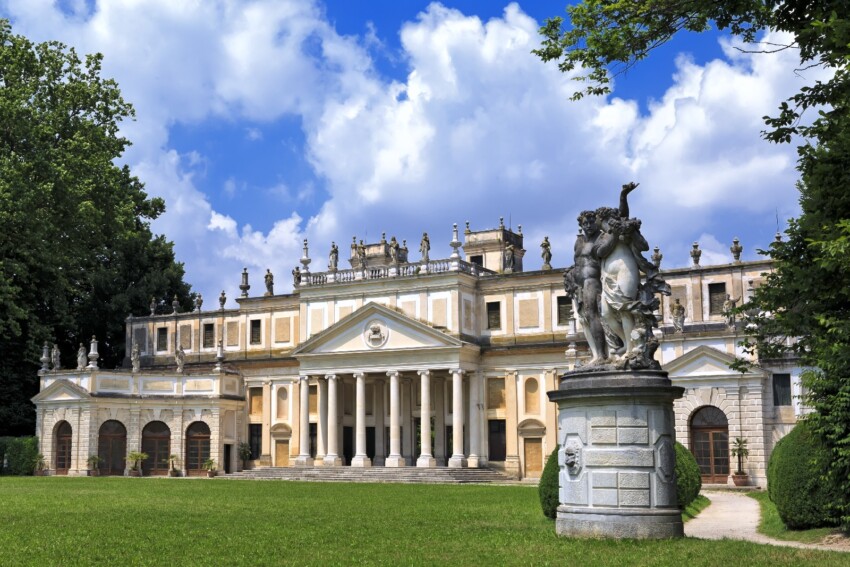

Between the fifteenth and eighteenth centuries, almost 4,000 stately homes were built in Veneto: the immense historical and architectural heritage bequeathed to us by what was a real fashion tells us of a past of industriousness that generated wealth, which in turn was transformed into beauty.
The patrons of these marvellous stately homes immersed in the countryside were the aristocratic Venetian families enriched during the many centuries of peace ensured by the stability of the Serenissima Republic. The Venetian villas fulfilled a twofold practical and celebratory function: they were both a highly organised agricultural estate and a refined stately residence, designed sometimes as a bucolic refuge and sometimes as a showplace to flaunt accumulated wealth.
Many villas are unfortunately in a state of abandonment, others are inhabited, and still others have been transformed into luxury restaurants or hotels, locations for weddings, meetings and congresses, photographic and film sets. The villas that can be visited are unmissable attractions to add to your Veneto travel programme.
You can create a two- or three-day themed tour, perhaps concentrating on the Riviera del Brenta area, or visit one or more villas in the course of a weekend or a more varied holiday. You will never be far from a villa because they are scattered everywhere! The most famous are concentrated in the provinces of Venice and Vicenza, but it is the province of Treviso that holds the record for the number of villas.
How to organise an itinerary of the Veneto villas? How to choose which villas to visit if you only have time for one or two? Are Palladio’s villas or the villas of the Riviera del Brenta more beautiful?
To help you choose, we have selected the 15 most beautiful Veneto villas and present them to you, dividing them into Palladian villas, Brenta Riviera villas and Euganean Hills villas. There is material for three different themed trips!
A commonplace that needs to be debunked is the belief that Palladian villas and Veneto villas are the same thing. In reality, if one considers the total number of Venetian villas, those built by the architect Andrea Palladio in the 16th century are only a small minority.
Of the almost 4,000,000 Venetian villas, only 166 can be visited and of these 24 are works by Andrea Palladio, all of them recognised as UNESCO World Heritage Sites. Among these 24 are some of the most beautiful and most visited Venetian villas ever, hence the widespread misunderstanding that sees the use of Venetian villas and Palladian villas as synonyms.
Palladian villas are scattered throughout the Veneto: here are the five most interesting and easiest to visit.

Villa Almerico Capra in Vicenza, better known as La Rotonda, is Palladio’s most famous villa: an exceptional work that marked the history of world architecture.
Like all Venetian villas, it stands in a rural setting, outside the city centre, and combines the private rooms of the noble residence and the rooms used for agricultural activities in a single building.
What makes this villa-temple perfectly integrated with the surrounding landscape unmistakable is its circular shape surmounted by an enormous dome: clearly inspired by the Pantheon in Rome, it is said to have been the inspiration for the White House in Washington.
With its perfect symmetry, classical beauty, innovative functional solutions for the time and a design inspired by the Renaissance vision of man at the centre of the world, La Rotonda is a kind of manifesto of the key principles of Palladian architecture. A top attraction not to be missed.
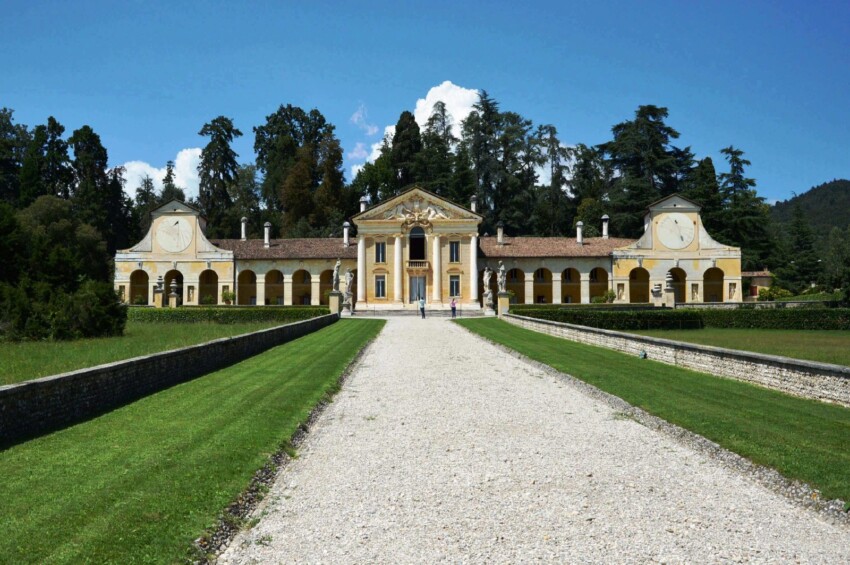
In the enchanting area of the Colli Asolani, in Maser, lies Villa Barbaro, another of Palladio’s most famous villas.
It was designed by Palladio in the mid-16th century as the seat of the agricultural estate of Daniele and Marcantonio Barbaro. The two brothers spared no expense, as in addition to the brilliant architect, they involved two other famous artists of the time, the painter Paolo Veronese and the sculptor Alessandro Volta, in the realisation of their ‘fattoria’.
Under the name ‘Villa di Maser‘, Palladio’s masterpiece continues to fulfil its original function: in fact, it is still today the site of an important farm and the private home of its owners. However, the piano nobile with the rooms frescoed by Veronese and the garden can be visited; you can also taste Villa di Maser wines in the elegant De Gustò bar located inside the farmhouse adjacent to the villa.
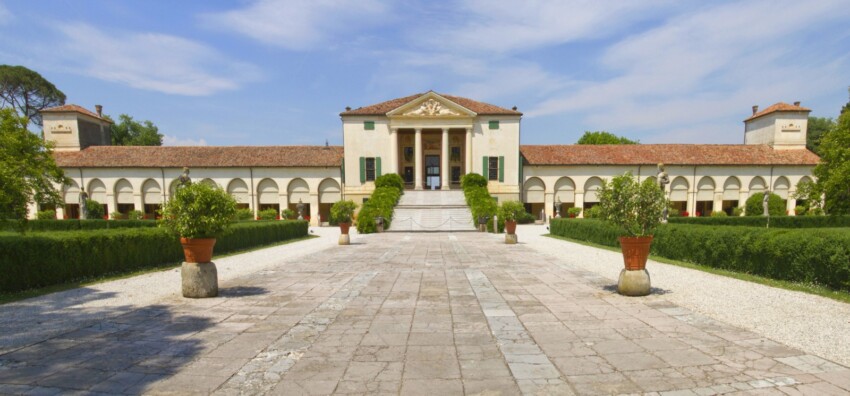
Staying in the Treviso area, the other Palladian villa not to be missed is Villa Emo in Fanzolo di Vedelago, designed by the brilliant architect when he already had 20 years of experience behind him. That this is a mature work is clearly demonstrated by the perfect proportions and symmetry governing the layout of the villa.
The exterior appears less opulent than that of other villas, while the interior is, as usual, richly decorated. The park we visit today does not correspond to Palladio’s original: no less than four different designs followed one another over the centuries.

Even in the less visited province of Rovigo, there are magnificent examples of Venetian villas. The best known of these is certainly Villa Badoer in Fratta Polesine known as La Badoera (be careful not to confuse it with Villa Badoere in the province of Treviso!).
Situated only 15 km from the centre of Rovigo and reachable in a day trip from the most beautiful locations of the Po Delta, it is a typical Palladian villa with a dual celebratory and practical function. Currently one of the two barchesse is the elegant home of the National Archaeological Museum of Fratta Polesine.
Lesser known but interesting to include in a tour of Palladian villas in Veneto is Villa Valmarana Bressan in Vigardolo, province of Vicenza (not to be confused with the Villa Valmarana Ai Nani, located a short distance from the centre of Vicenza).
It was built between 1542 and 1545 and is recognised by art historians as one of the first projects realised by Palladio in total autonomy. Although it does not reach the artistic levels of his mature works, it already presents numerous elements that would become a constant in his architectural style.
The villa can be visited from April to October.
Called the ‘Venice of the Mainland’, the Riviera del Brenta is the most fascinating area of the Venetian hinterland. Its name evokes images of a bucolic countryside embellished by artistic masterpieces inspired by the aesthetic canons of classicism. This image is the result of a ‘fashion’ that developed in the golden centuries of the Serenissima Republic, which prompted the wealthiest families of the Venetian aristocracy to build themselves a villa along the banks of the river Brenta.
From a tourist point of view, the most interesting part of the Riviera del Brenta is from Stra to Fusina, where the river meets the Adriatic Sea (about 25 km); the ideal centre of the Riviera is the pretty town of Dolo.
There are few villas on the Riviera del Brenta that can be visited, and with careful planning it is possible to visit them all in one day. However, it is advisable to break the itinerary of the Brenta villas into two days or, even better, to join a guided boat tour with a visit to the most famous villas.
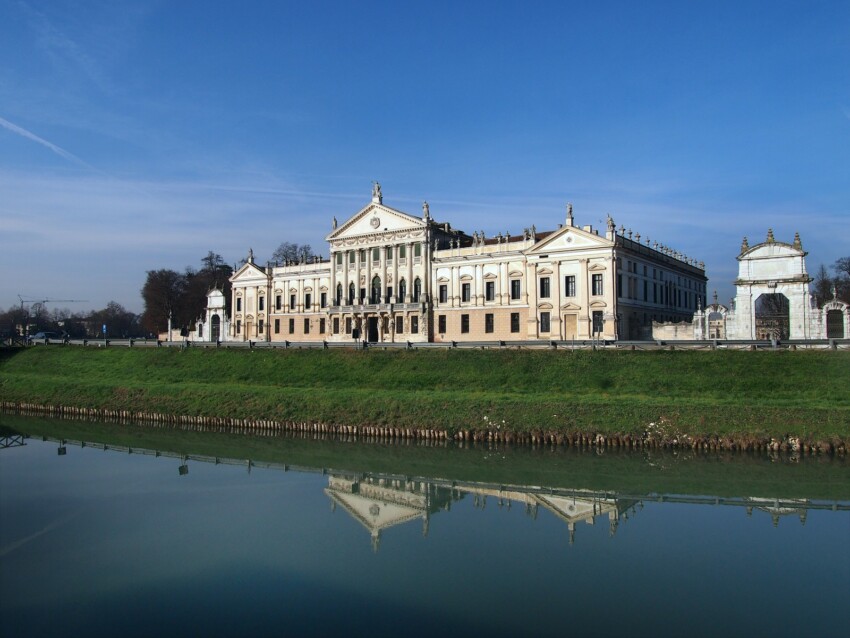
If you only have time for one villa on the Riviera del Brenta, choose Villa Pisani in Stra without hesitation. Considered the ‘Queen of Venetian Villas’, it can be considered the swan song of the Riviera del Brenta.
Its construction, subsequent to those of many other villas in the area, was commissioned by the noble Venetian Pisani family, whose most famous member was Doge Alvise Pisani. The family fell into ruin at the end of the 18th century, but not the villa, which was first purchased by Napoleon Bonaparte, then became the property of the Habsburgs of Austria and finally in 1866 the property of the newly-born Kingdom of Italy. Each lineage made embellishments and improvements, and as early as 1884 the villa became the site of a national museum still open to visitors today.
For centuries a meeting place for politicians, writers and artists, Villa Pisani is now one of the most visited attractions in the Veneto. It is only possible to see a few of the 114 sumptuous rooms inside (including the Napoleonic flat), but the rooms that can be visited are enough to give you an idea of the grandeur of this villa-queen.
The tour inside culminates in the grand ballroom frescoed by GianBattista Tiepolo, but you can continue your visit outside in the immense park with one of the most important hedge mazes in Europe.
A complete tour of the villa and garden requires at least two to three hours; allow a little extra time for a relaxing stop at the elegant café converted from the old stables.
Also in Stra, not far from Villa Pisani is Villa Foscarini Rossi, a 17th-century villa commissioned by the Venetian nobleman Jacopo Foscarini as a place to spend a peaceful old age. He chose an existing country residence along the banks of the Brenta River and had it completely renovated; the family carried out the decoration of the villa with the help of important artists such as Giuseppe Jappelli, Pietro Liberi and Domenico de Bruni.
Today, the villa is owned by the Rossi family, founders of an important local shoe factory that has collaborated with famous designers such as Fendi, Yves Saint Laurent, Givenchy and other leading names in Italian and international fashion.
Part of the villa is used for weddings, cultural and corporate events; some of the rooms house the Museo della Calzatura (Shoe Museum), which exhibits more than 1,500 models of luxury women’s shoes made by the Rossimoda shoemaker in its seventy years of activity; there is also a small collection of 18th- and 19th-century Venetian shoes.
The establishment of a museum dedicated to footwear in this area is no coincidence: the production of quality shoes has a long tradition on the Riviera del Brenta, and in Stra in particular, so much so that the area has become one of the main industrial poles in the sector.
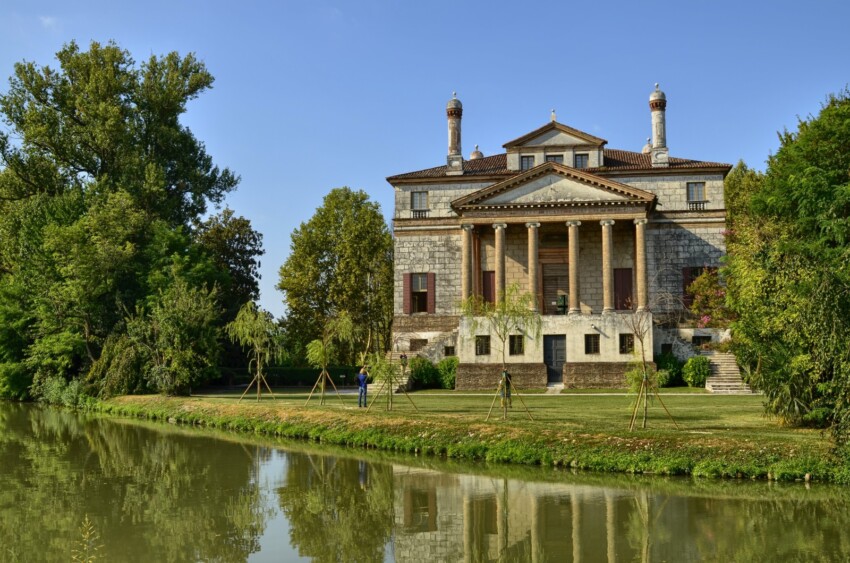
Villa Foscari known as La Malcontenta in Mira is the only villa on the Riviera del Brenta designed by Andrea Palladio. Like other Palladian villas, this building follows the classic three-storey model and has perfect symmetry, in this case necessary to create two identical flats joined by a common central space. The interior of the Piano Nobile is embellished with a cycle of frescoes in which important 16th-century Venetian painters participated.
To avoid flooding of the piano nobile during the flooding of the Brenta, Palladio devised a sort of podium on which the villa rests: a practical expedient that gave the complex a greater monumentality and elegance.
Surrounded by green meadows, weeping willows and water cypresses, La Malcontenta is an unmissable stop on any trip to the Riviera del Brenta. Guided tours are led by architect Antonio Foscari, a descendant of the family that commissioned the villa.
It looks tiny in comparison to Villa Pisani, but Villa Widmann Rezzonico Foscari (more often called Villa Widmann) in Mira is another marvel for the eyes and hides unsuspected treasures. In 18th-century Rococo style, it is lavishly decorated with stucco, frescoes, brocades and Murano chandeliers; the furniture is original period.
Lying on a bend in the Brenta River, the villa was built by a noble Venetian family of Persian origin but its original appearance is due to the later owners, the Widmanns; it is currently owned by the Metropolitan City of Venice, which explains the slightly lower ticket price than other villas.
A curious object you can admire inside the villa is the felze, a roof traditionally used for Venetian boats while the portico of the barchessa houses a collection of antique carriages.
The villa has a large park that includes a romantic pond with water cypresses.
The historical origins of Villa Badoer Fattoretto date back to the 16th century, but it was in the first half of the 18th century that this noble residence in Dolo reached its splendour. Its most famous owner was Baron Chantal, and even more famous is his love affair with the beautiful lady across the road.
In 1945 it was bought by the Fattorettos, a family of winegrowers interested in the land adjacent to the villa, and restored some 20 years later. Still inhabited today, the villa can be visited by guided tour in the spring and autumn months; at other times of the year it can only be visited by appointment.
Some rooms of the villa house the Museo del Villano, a collection of tools, instruments and historical documents that tell of the life of the villages that grew up around the elegant villas of the Riviera.
There is no shortage of curious relics, such as the ancestor of the exercise bike or a price list of a closed house, and others of great historical importance, such as a collection of Doge’s letters or an edict issued by Napoleon on his only day at the Royal Palace in Stra.
Visitable by appointment only, Villa Venier Contarini is an interesting addition to the classic tour of the most famous villas. It is located in Mira, a short distance from the famous Villa Pisani and Villa Foscari ‘La Malcontenta’.
It is one of the oldest villas along the Riviera del Brenta: the manor house dates back to the 16th century. It was purchased by the Venier family in 1660, who held it until the death of the last male descendant in 1780; it was inherited by Maria Venier, wife of Alvise II Contarini.
Less famous than the Palladian villas of Vicenza and Treviso or the villas of the Riviera del Brenta, the Veneto villas south of Padua are also worth a visit for their architectural beauty and the natural setting in which they are set, almost a hymn to idleness and contemplation.
The setting is that of the Euganean Hills, the low hills of volcanic origin that grow some ten kilometres or so from the centre of Padua: a verdant area of sweet beauty extolled over the centuries by poets of the calibre of Petrarch and Foscolo.

Villa Barbarigo in Valsanzibio is a corner of the Riviera del Brenta in the Euganean Hills. It lacks a river, but otherwise this elegant mansion built in the second half of the 17th century faithfully follows the model of the villas of the Venetian hinterland and, just like those, was owned by a wealthy Venetian family.
The villa is only open to the public on special occasions, while the splendid Baroque monumental garden can always be visited (independently or with guided tours). A visit to the garden is a fairytale journey, marked by statues, small temples, pavilions, staircases and, of course, a huge variety of trees and plants; there is also an allegorical walkway and a labyrinth.

Culture is in the DNA of the elegant Villa dei Vescovi in Luvigliano (Torreglia): it was originally the seat of an intellectual circle in the 16th century, conceived as a place to stimulate deep reflection, and today is used as an attractive location for cultural events managed by the FAI.
It is possible to take part in guided tours of the villa; the outdoor spaces, with free admission, are a green refuge for Paduans escaping the stifling heat of the city.

The Catajo Castle at Battaglia Terme is a Veneto villa that is somewhat atypical because it combines the elegance traditionally associated with such architectural works with an almost militaristic rigour.
The origin of this strange mixture of styles is to be found in the first owners of the villa, who were not Venetian aristocrats (as in almost all Venetian villas) but the descendants of a family of captains of fortune who arrived in Italy in the retinue of Emperor Arrigo II in 1007.
“La reggia dei Colli Euganei” was built in the 16th century and for centuries hosted sovereigns from all over Europe visiting the Euganean Hills. Currently privately owned, it is used for weddings, cultural events, and corporate meetings.
From spring to autumn, the Piano Nobile and the garden are open to visitors.
Faithful to the tradition of Venetian villas as workplaces and noble residences, the Villa Emo Capodilista in Selvazzano Dentro is home to a well-known wine-producing farm and residence of the same family that has owned it since the Middle Ages. It is also called La Montecchia after the hill in the Euganean Hills Regional Park on which it stands.
Built at the end of the 16th century as a hunting reserve, it was designed and decorated by a painter and pupil of Veronese who also cultivated a passion for architecture.
The villa now houses the farm’s wine shop, a b&b and four luxury holiday flats and the private rooms now inhabited by Count Giordano Emo Capodilista.
It can be visited all year round by reservation for groups of at least 15 people; on special dates it is open to individual visitors or small groups.
In the following map you can see the location of the main places of interest mentioned in this article.